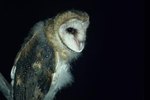Determining with 100 percent accuracy whether a barn owl is male or female can be a daunting task even for experts. It is difficult to know what sex a barn owl is without comparing it to a barn owl of the opposite sex, and even then, it is not an exacting science. Sometimes the sex can not be determined without veterinarian assistance.
Barn Owl Fast Facts
The barn owl is the most popular and widespread species of owl. The barn owl is found almost anywhere in the world save for deserts, the North and South Poles, Indonesia and the Pacific Islands. Barn owls have long wings and legs with a short tail and a large, white, heart-shaped face. The wingspan on a barn owl is 30 inches to 43 inches and the owl averages 9 inches to 18 inches in height. Barn owls are carnivores, silently hunting mice and other small animals usually three times a day; once at dusk, again at midnight and once more before dawn. They fly silently and gracefully. Although they can not actually see in the dark, they can hunt in light too dim for a human's eyes. They have a shrill screech that is heard for long distances. The screech, combined with their dark eyes and white face, have given the barn owl some random other names, for example, white owl, ghost owl, night owl, hissing owl, hobgoblin and delicate owl.
Barn Owl Habitat
Barn owls do live in old barns and buildings. However, they are not relegated to only old buildings as housing. Barn owls also live in trees, usually closely bunched evergreen trees, but in other trees as well, including palm trees. Owls are pretty sloppy when it comes to making nests. They use leaves and branches from the trees they live in, padding the nest with an unusual item: their own excrement. When an owl eats a mouse, the bones and the fur are passed whole in the owl's feces. Barn owls do not get large enough to swoop down and grab hapless dogs or cats from their yards. However, they have spot-on accuracy when it comes to swooping down on a small bird, mouse or other rodent. Many people have barn owls living in their trees without even knowing it until they hear the chilling screech.
Male and Female Size Body Differences
The first item separating male from a female is size. Like many other raptors, the female is slightly larger than the male. She also has darker legs while the male has singularly pale legs. The female's beak is buff color; however, the male's beak is more of an ivory color. The female can weigh up to 1 lb. more than the male with a slightly wider wingspan. Obviously these differences would mean nothing to the casual observer who does not have a male and female sitting side by side.
Male and Female Coloring Differences
In some barn owls, it is possible to determine the sex without an owl of the opposite sex to compare. This determination is made by the coloring of the feathers. A male has a white throat, while a female has a brown one. The throat coloring on both owls extends along the sides of their heads just behind the face disk in their respective colors. The under wings of the male and the female owls are white. However, a female will have miniscule black spots near the joint of the wing. The spots can be as small as the head of a pin or as large as the end of a matchstick. The back feathers of the male are very pale brown or yellowish with areas of light gray and white. Females have brown and darker gray back feathers. The tail feathers of the males are pale buff or white with light gray. Females are brown with darker gray or black barring. The trailing end of each wing feather is white in both male and female. The main portion of each wing feather is golden brown with light gray barring for male and brown with black or dark gray barring for the female. One thing that should be kept in mind when trying to sex barn owls, the older a female gets, the less characteristically female she becomes. A female barn owl's coloring can change as she ages making it harder to tell her from a male.
References
Photo Credits
-
Jupiterimages/Photos.com/Getty Images





